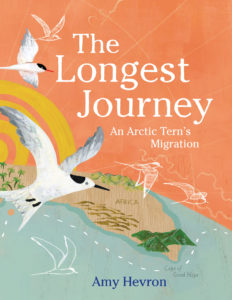“Fun Ways to Bring Animal Migration into the Classroom”
I love birdwatching and am fascinated by migrating birds. In The Longest Journey: An Arctic Tern’s Migration, I showcase an epic migrator on her first globe-spanning adventure. When I began writing this story, I wondered, what would it be like to travel across the globe? Across every climate zone from polar lands to temperate zones, to subtropics and tropics? What would the landscapes look like? What other animals would be along the way? Piecing together this little seabird’s journey was fascinating and combined my passions for wildlife, world geography, Earth sciences and art. Here are some fun ways kids can explore animal migration and mapmaking in the classroom.
Track birds in your area
Birds are all around us. And whether they are year-round residents or just here for the season, these wildlife neighbors of ours are fascinating to learn more about. Kids could pick a migrating bird from your area and find out where they migrate. They could plot their bird’s journey on a world map. What cities, states, countries, and continents does this local bird see? Kids could learn about their bird’s life cycle and draw how it looks at the different life stages from egg, to chick, to juvenile, to adult. Many birds migrate in their first year of life. At what age does their bird migrate? They could find out what kind of habitat their bird lives in, what kind of nest it makes, and what kind of food it eats. And in learning more about its migration, kids could think about what obstacles this bird might encounter or what amazing sites it might see on its journey. A helpful site to find out more about birds in your area is www.allaboutbirds.org. Also, the Audubon app for smart phones and tablets is a great birding resource as well.
Track other Arctic migrators
In addition to Arctic terns, other Arctic animals migrate, like narwhals and Pacific walruses. Kids could pick a different Arctic animal and explore the migration of this species. Why does it migrate? What might that journey look like on a map? By focusing on other animals that live in the Arctic region, this could provide an opportunity to discuss the impacts of climate change on wildlife as well. Animals that live in the Arctic are especially sensitive to global warming because the Arctic is warming at a faster rate than elsewhere in the world. How is their Arctic animal impacted by warming land and oceans? How is it adapting? Additionally, you could talk about the Earth’s seasons as they relate to the Arctic and how around Summer Soltice the sun never sets, and in Winter it is dark all day. How do the Arctic seasons affect their animal’s activities? The Active Wild website lists a range of interesting Arctic animals to learn more about (https://www.activewild.com/arctic-animals-list/).
Dive into mapmaking
A fun way to learn about world geography is through creating maps. Kids could create a map of their own migration adventure, either real or imaginary. They could start with a whole world map, a continent or a country. Kids could add traditional map details like labels for the land, bodies of water, and a compass with North, South, East, and West. On a world map, kids could add in the major latitudinal lines of the Equator, Tropic of Cancer, Tropic of Capricorn, the Arctic circle and Antarctic circle. They could learn about how the climate is different at these different latitudes. They could research and then illustrate different flora and fauna on the map within their appropriate climate zones. From here, kids could plot their migration path. Where would their journey take them? What sites would they see? What food would they eat along the way? A fun tool to use for research is Google Earth (earth.google.com). You can zoom in to see what the landscape looks like anywhere on Earth. Also, Google image searching “illustrated maps” can provide some inspiration for different ways to illustrate maps. Wikipedia’s site provides different world map images, including this simple world map that could be used as a starting point https://commons.wikimedia.org/wiki/File:A_large_blank_world_map_with_oceans_marked_in_blue.PNG.
Published July 12, 2022 by Neal Porter Books
About the Book: Follow the epic annual migration of an Arctic Tern on its sixty-thousand-mile journey to the South Pole and back again, the longest such migration in the animal kingdom.
In their thirty-year lifetimes, Arctic Terns travel nearly 1.5 million miles, that’s enough to fly to the Moon and back three times! Each year they brave blistering winds, storms, rough seas, and airborne predators as they travel between the Earth’s poles, chasing the summer. In The Longest Journey: An Arctic Tern’s Migration, we follow one such bird as it spreads its wings and sets out to make its first globe-spanning trip with its flock.
Amy Hevron is the illustrator of Trevor by Jim Averbeck, the recipient of multiple starred reviews. She also illustrated Candace Fleming’s The Tide Pool Waits which was the recipient of the Portfolio Honor Award from the Society of Children’s Book Writers and Illustrators. Her brilliant, naturalistic artwork mimicking maps and nautical charts is supported by extensive research and paired with material at the back of the book explaining the science behind the life cycle of Arctic Terns.
About the Author: Amy Hevron is an illustrator, designer, and children’s book author. She wrote and illustrated Dust Bunny Wants a Friend and illustrated Trevor by Jim Averbeck, which received multiple starred reviews. She also illustrated The Tide Pool Waits, by Candace Fleming. In both 2015 and 2016, she received the Portfolio Honor Award from the Society of Children’s Book Writers and Illustrators. She lives in Seattle with her family.
https://www.amyhevron.com/
@amyhevron on Instagram and Twitter
https://holidayhouse.com/book/the-longest-journey/
@holidayhousebks on all social platforms
Thank you, Amy, for these fun migration activities for the classroom!



1 thought on “Author Guest Post: “Fun Ways to Bring Animal Migration into the Classroom” by Amy Hevron, Author of The Longest Journey: An Artic Tern’s Migration”